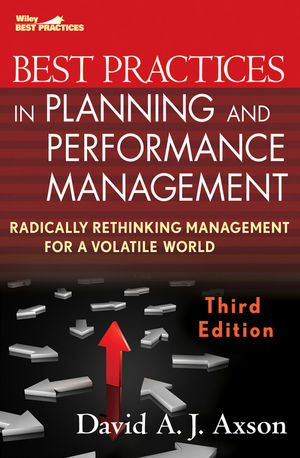
Best Practices in Planning and Performance Management
John Wiley & Sons Inc (Verlag)
978-0-470-53979-8 (ISBN)
A practical framework for effectively managing performance in today's complex, competitive and risky global markets
The Third Edition provides a complete framework for building best practice management processes for today's complex and uncertain world. Fully updated to reflect the events of the global economic crisis, this book provides further practical examples of companies that are successfully using the practices identified.
Updated for the implications of the global economic crisis on management practices
Completely rewritten section on "What it Takes To Be An Effective Manager In An Uncertain World
Added examples and mini case studies throughout the book from companies such as Qualcomm, IBM, Dominos, Target, Toshiba and Facebook
Establishes new benchmarks for performance management process and practice
Fully updated to include recent events, new learnings, technologies and emerging best practices
This book includes serious rethinking of the way companies plan and manage performance-from the role of accounting to the skills needed to be an effective manager-including new technologies, techniques and real time management processes.
DAVID A. J. AXSON is President of the Sonax Group, a business advisory firm. He is a former head of corporate planning at Bank of America and was a cofounder of The Hackett Group, where he was the architect of the firm's market-leading benchmarks bank. He is a sought-after speaker and writer on best practices in planning and performance management reporting, and is widely regarded as a thought leader in the industry.
Preface to the First Edition xi
Preface to the Third Edition xiii
Acknowledgments xv
Introduction 1
PART ONE WHY PERFORMANCE MANAGEMENT MATTERS
1 Traditional Management Processes Are Obsolete 5
Better-Informed Customers 6
Changing Market and Business Models 7
Structural Change in the Economics of Business 10
Globalization 13
Regulatory Revolution 13
Growth through Acquisition as the Normal Course of Business 15
Redefining Asset Values 16
Changing Delivery Channels 17
Compressed Cycle Times 17
Vast New Information Sources 18
Technology and Systems 19
Need for a Burning Platform 22
2 What Is Performance Management? 24
Defining Performance Management 24
Best Practices Defined 27
Types of Best Practice 31
Applying Best Practices 32
Best Practice Adoption Is Now a Necessity 34
3 Sizing the Opportunities 38
Beyond Benchmarking 38
Defining the Right Metrics 39
Conclusion 57
PART TWO BEST PRACTICES
4 Using Best Practices to Drive Change 61
A Brief History 61
From Battlefield to Boardroom 63
Components of a Best Practice Framework 65
Best Practice Recipe 65
Selecting the Right Best Practices 65
Golden Rule of Best Practice Application 68
Time to Sacrifice a Few Sacred Cows 69
No Silver Bullets 73
5 Strategic Planning: Ideas That Drive Results 74
Defining Strategy 76
Typical Process 77
Strategic Planning Best Practices 79
Communicate, Communicate, Communicate 92
Strategic Planning Is a Collaborative Process 93
CEO as Chief Strategist 93
Hard Side of Strategy 94
Acid Test 106
Lessons for a Volatile World 106
Best Practice Summary 106
6 Tactical and Financial Planning: Translating Strategy into Action 109
Defining Tactical and Financial Planning 109
Typical Process 110
Tactical Planning Best Practices 111
Financial Planning Best Practices 126
Lessons for a Volatile World 137
Best Practice Summary 138
7 Management Reporting: From Information to Insight 140
Typical Process 143
Management Reporting Best Practices 145
Putting It All Together 166
Lessons for a Volatile World 168
Best Practice Summary 168
8 Forecasting: Pass the Crystal Ball 171
Typical Process 172
Forecasting Best Practices 173
Understand Variability 192
Lessons for a Volatile World 193
Best Practice Summary 194
9 Risk Management: Place Your Bets 196
No Excuses 197
Global Interdependence 198
Developing an Effective Business Risk Management Capability 204
Risk Mitigation Techniques 217
Lessons for a Volatile World 219
10 Technology: Panacea or Pain? 221
Evolution of Information Technology in Business 222
Why the Time for Convergence Is Right 224
Applying Technology to Performance Management— Dawn of the Digital Manager 224
Best Practices for Leveraging Technology 229
Lessons for a Volatile World 240
Best Practice Summary 241
PART THREE MOVING FROM DATA TO DECISIONS
11 Implementing Best Practices 245
Getting Started 245
Moving to Implementation 247
Understand the Overall Strategic Goals and Objectives 248
Define the Critical Success Factors and Drivers 249
Define the Appropriate Performance Measures 251
Link Measures to the Overall Strategy 253
Define the Reporting Dimensions 253
Detail and Source the Performance Measures 253
Design the User Experience 255
Design and Build the Reporting Process 256
Integrate the Reporting and Planning Processes—Align Incentives 256
Develop the Required Skills 257
12 Implementation Secrets 259
Learn from the Mistakes of Others 259
Effect Change and Then Sustain It 261
It’s about Commitment and Execution 273
13 Managing in an Uncertain World 274
Leadership Qualities 275
Don’t Underestimate the Impact of Leaders 281
14 Looking to the Future 283
Fast, Flawless Execution Will Be the Distinguishing Characteristic of World-Class Companies 283
Global Accounting and Reporting Standards Will Become a Reality 285
The Focus Will Shift from Buying Technology to Using It 286
The Annual Budget Will Die—and Few Tears Will Be Shed 287
Finance Executives Will Require New Skills or New Jobs 288
Final Thoughts 288
About the Author 291
Index 293
| Erscheint lt. Verlag | 20.8.2010 |
|---|---|
| Reihe/Serie | Wiley Best Practices |
| Zusatzinfo | Exhibits: 100 B&W, 0 Color |
| Verlagsort | New York |
| Sprache | englisch |
| Maße | 160 x 236 mm |
| Gewicht | 522 g |
| Themenwelt | Wirtschaft ► Betriebswirtschaft / Management ► Finanzierung |
| Wirtschaft ► Betriebswirtschaft / Management ► Rechnungswesen / Bilanzen | |
| Wirtschaft ► Betriebswirtschaft / Management ► Unternehmensführung / Management | |
| ISBN-10 | 0-470-53979-8 / 0470539798 |
| ISBN-13 | 978-0-470-53979-8 / 9780470539798 |
| Zustand | Neuware |
| Haben Sie eine Frage zum Produkt? |
aus dem Bereich


